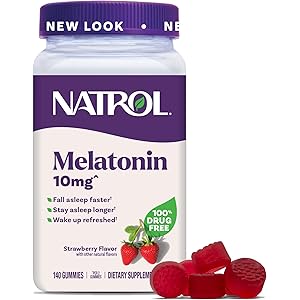Natrol Melatonin Gummies, Sleep Support for Adults, Melatonin 10 mg, 140 Strawberry-Flavored, Up to 70 Days
$14.58 (as of September 30, 2025 21:15 GMT +00:00 - More infoProduct prices and availability are accurate as of the date/time indicated and are subject to change. Any price and availability information displayed on [relevant Amazon Site(s), as applicable] at the time of purchase will apply to the purchase of this product.)Understanding Micronutrients RDA
Micronutrients are essential vitamins and minerals required by the body in small amounts to maintain proper health and well-being. The Recommended Dietary Allowance (RDA) for micronutrients provides guidelines on the daily intake levels necessary to prevent deficiencies and support optimal physiological functions. Understanding the RDA for micronutrients is crucial for individuals aiming to achieve a balanced diet and enhance their overall health.
The Importance of Micronutrients
Micronutrients play a vital role in various bodily functions, including immune response, bone health, and energy production. They are involved in metabolic processes and are necessary for the synthesis of hormones and enzymes. A deficiency in micronutrients can lead to a range of health issues, including weakened immunity, poor bone density, and chronic fatigue. Therefore, adhering to the RDA for micronutrients is essential for maintaining good health and preventing diseases.
Micronutrients: Types and Sources
Micronutrients are categorized into two main groups: vitamins and minerals. Vitamins, such as Vitamin A, C, D, E, and the B-complex vitamins, are organic compounds that the body needs for various functions. Minerals, including calcium, iron, magnesium, and zinc, are inorganic elements that contribute to structural and functional roles in the body. A diverse diet rich in fruits, vegetables, whole grains, nuts, and lean proteins can help individuals meet their micronutrient RDA.
Micronutrients RDA for Adults
The RDA for micronutrients varies by age, sex, and life stage. For instance, adult men typically require higher amounts of certain vitamins and minerals compared to women. The RDA for Vitamin C is 90 mg for men and 75 mg for women, while the RDA for iron is 8 mg for men and 18 mg for women. Understanding these differences is essential for tailoring dietary choices to meet individual health needs.
Micronutrients RDA for Children and Adolescents
Children and adolescents have unique nutritional needs as they grow and develop. The RDA for micronutrients in this age group is designed to support growth, cognitive development, and overall health. For example, the RDA for Vitamin D is 600 IU for children and adolescents, which is crucial for bone health. Parents should ensure that their children receive a balanced diet that meets these requirements.
Micronutrients RDA During Pregnancy and Lactation
Pregnant and lactating women have increased micronutrient needs to support fetal development and milk production. The RDA for folate, for instance, is 600 mcg during pregnancy to help prevent neural tube defects. Additionally, the RDA for iron increases to 27 mg to support the increased blood volume and prevent anemia. It is vital for expectant mothers to consult healthcare providers to ensure they meet these dietary recommendations.
Assessing Micronutrient Intake
To assess whether you are meeting the RDA for micronutrients, consider keeping a food diary to track your daily intake. Various apps and online tools can help analyze your diet and identify any deficiencies. Additionally, regular health check-ups and blood tests can provide insights into your micronutrient levels, allowing for timely dietary adjustments if necessary.
Supplementing Micronutrients
While a balanced diet is the best way to obtain essential micronutrients, some individuals may require supplements to meet their RDA. This is particularly true for those with dietary restrictions, certain medical conditions, or increased nutritional needs. However, it is crucial to consult with a healthcare professional before starting any supplementation, as excessive intake of certain micronutrients can lead to toxicity and adverse health effects.
Challenges in Meeting Micronutrients RDA
Many people struggle to meet the RDA for micronutrients due to various factors, including busy lifestyles, lack of access to fresh foods, and dietary preferences. Processed foods often lack essential vitamins and minerals, making it challenging to achieve the recommended intake. Educating oneself about nutrient-dense foods and meal planning can help overcome these challenges and promote better health.
The Future of Micronutrient Research
Ongoing research continues to explore the roles of micronutrients in health and disease prevention. Emerging studies are investigating the impact of micronutrient deficiencies on chronic diseases and the potential benefits of personalized nutrition. As our understanding of micronutrients evolves, it will become increasingly important to stay informed about dietary recommendations and their implications for health and wellness.


